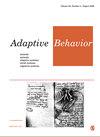植物的刺激能协调与最小认知
IF 1.3
4区 计算机科学
Q4 COMPUTER SCIENCE, ARTIFICIAL INTELLIGENCE
引用次数: 2
摘要
植物认知辩论中的棘手问题是,应该使用什么样的认知理论来固定认知概念的引用,而不以任何方式过度扭曲辩论。毕竟,植物在许多方面与动物截然不同:它们没有运动能力,没有中枢神经系统甚至神经元,没有表现出不变的形态,以分布式多中心的方式与世界互动,并通过生理学的变化来表现。尽管如此,在这场争论中,有一条重要的线索断言植物确实具有认知能力。但是,如果不考虑先前的动物学假设,什么样的认知理论能够理解这一说法呢?本文的目的是尝试一种最小认知理论,使植物认知的说法可信。它主要受到分布式认知文献和van Duijn等人提出的认知感觉运动协调理论的启发。(2006)。我们认为认知系统是一组协调的半自主过程,在生物体及其环境中运行。协调的特点是两个功能条件,确保系统在世界上产生目标导向的行动。从某种意义上说,该系统是污名能的,因为它在环境中的行动的物质结果是协调进一步行动的过程的关键部分。该描述具有一定程度的尺度不变性,有助于统一微生物、植物和动物的认知解释。本文章由计算机程序翻译,如有差异,请以英文原文为准。
Stigmergic coordination and minimal cognition in plants
The tricky question in the plant cognition debate is what theory of cognition should be used to fix the reference of cognitive concepts without skewing the debate too much one way or the other. After all, plants are rather different to animals in many respects: they are not motile, do not possess central nervous systems or even neurons, do not exhibit an invariant morphology, interact with the world in a distributed multi-centred manner, and behave through changes in their physiology. Nonetheless, there is a significant strand in the debate that asserts that plants are indeed cognitive. But what theory of cognition makes sense of this claim without baking in prior zoological assumptions? The aim of this paper is to try out a theory of minimal cognition that makes the claim of plant cognition plausible. It is primarily inspired by the distributed cognition literature and the sensorimotor coordination theory of cognition proposed by van Duijn et al. (2006). We take a cognitive system to be a coordinated set of semi-autonomous processes running over the organism and items in its environment. Coordination is characterised in terms of two functional conditions that ensure that the system generates goal-directed action in the world. The system is stigmergic in the sense that the material results of its actions in the environment are a crucial part of the processes that coordinate further actions. The account possesses a degree of scale invariance and helps unify cognitive explanation across microorganisms, plants and animals.
求助全文
通过发布文献求助,成功后即可免费获取论文全文。
去求助
来源期刊

Adaptive Behavior
工程技术-计算机:人工智能
CiteScore
4.30
自引率
18.80%
发文量
34
审稿时长
>12 weeks
期刊介绍:
_Adaptive Behavior_ publishes articles on adaptive behaviour in living organisms and autonomous artificial systems. The official journal of the _International Society of Adaptive Behavior_, _Adaptive Behavior_, addresses topics such as perception and motor control, embodied cognition, learning and evolution, neural mechanisms, artificial intelligence, behavioral sequences, motivation and emotion, characterization of environments, decision making, collective and social behavior, navigation, foraging, communication and signalling.
Print ISSN: 1059-7123
 求助内容:
求助内容: 应助结果提醒方式:
应助结果提醒方式:


